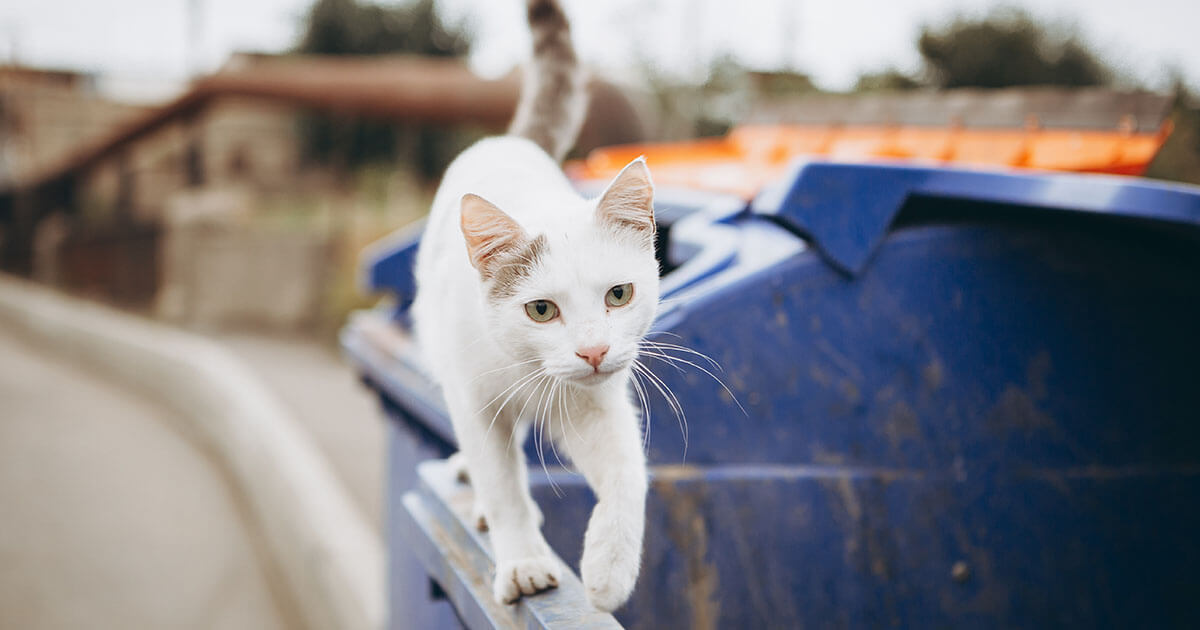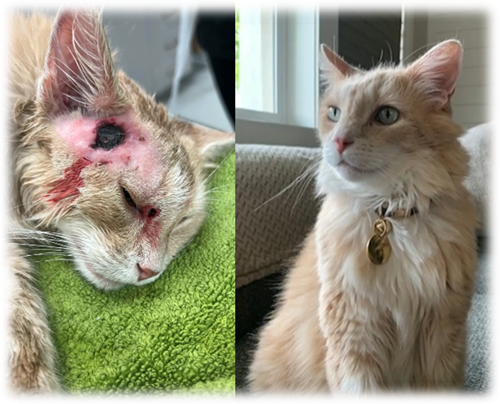A stray cat is a domestic feline that lives outdoors and does not have a permanent home. These cats often survive on their instincts and can be found in urban or rural areas.
Stray cats, sometimes distinguished from feral cats, are known for their resilience and ability to adapt to life outside a traditional home. Often, these cats were once pets that have been lost or abandoned, so they may be more accustomed to human interaction than feral cats.
Communities around the world encounter stray cats with various responses, from rescue and adoption efforts to trap-neuter-return (TNR) programs, which aim to control the stray population and improve their health and welfare. Concerns about stray cats include their impact on wildlife and the spread of diseases. Therefore, many animal welfare organizations encourage spaying and neutering to prevent the increasing populations of strays, advocating for humane solutions to assist these animals in need.
Life On The Streets For Felines
Imagine a life without a cozy bed or a regular meal. This is the reality for many stray cats. They roam our streets and alleyways, living a life that’s far from easy. Let’s dive into the daily struggles these feline friends face in their quest for survival.
The Struggle For Food
Food is scarce on the streets. Stray cats must hunt or scavenge to eat. They often rely on:
- Dumpsters: Searching through trash can be dangerous but necessary.
- Small prey: Mice and birds can provide a meal, but they’re not always available.
- Generous humans: Some feed strays, offering a lifeline in tough times.
Finding Shelter From The Elements
Stray cats need shelter from rain, cold, or heat. They find creative places to stay safe. These include:
- Abandoned buildings: Old structures provide cover but are not always safe.
- Parked cars: They offer warmth, yet pose risks when unknowingly used.
- Dense foliage: Bushes and trees shield them from weather and threats.
Avoiding Danger: Predators And Traffic
The street is full of dangers for stray cats. They stay on alert for:
- Predators: Dogs and wild animals threaten their safety daily.
- Traffic: Cars are a constant worry, with busy roads being high-risk areas.
- Humans: Not all humans are kind, and strays must be cautious of ill intentions.

Credit: www.peta.org
Feral Vs. Stray: Understanding The Difference
When wandering through neighborhoods or exploring the hidden corners of an urban landscape, you might spot a furry creature with cautious eyes peeking at you. These feline figures often spark a question: are they stray or feral cats? Understanding this distinction is crucial for their welfare and our interactions with them.
A Past With Humans: Stray Cats
Stray cats are no strangers to human touch. They have lost their homes or wandered away from their familiar surroundings. Unlike their feral counterparts, strays might approach people, vocalize, and even allow touching. A stray cat can often be reintegrated into a home environment.
Born Wild: Feral Cats
Feral cats are offspring of strays or other ferals and have had little to no human contact. Skittish and self-reliant, these cats typically steer clear of human touch. Feral cats view the outdoors as their home and form colonies with complex social structures. Living wild, they are not ideal candidates for domestication.
Interactions With People And Other Animals
| Type | Approachability | Interaction with Humans | Relation with Other Animals |
|---|---|---|---|
| Stray Cats | Higher | May seek out or accept human attention | Varies; may be social or isolated |
| Feral Cats | Lower | Avoids humans and prefers distance | Typically found in groups, less interaction with other species |
Recognizing the difference between feral and stray cats is essential for providing the appropriate care and support. Stray cats may seek to reconnect with human companions, while feral cats thrive with minimal human intervention. Respecting these differences ensures we can coexist with these captivating creatures responsibly.
Health Hazards And First Aid
Stray cats face many dangers in the outdoors. They often lack proper care. This includes good food and medical attention. In this post, we discuss common diseases and injuries. You will also learn first aid tips to help these felines. Knowing how to help can make a big difference. Let’s also explore why spaying and neutering is essential.
Common Diseases Among Street Cats
Street cats can catch various diseases. These can spread from cat to cat. Some common ailments include:
- Feline leukemia (FeLV): This weakens their immune system.
- Feline immunodeficiency virus (FIV): Similar to human HIV, but for cats.
- Upper respiratory infections: These can cause sneezing and runny noses.
It’s vital to watch for symptoms. Early treatment can save lives. Find a vet if you spot a sick stray.
Injuries And How To Help
Street cats often get hurt. Look out for these signs:
| Type of Injury | What to Do |
|---|---|
| Cuts | Apply gentle pressure with a clean cloth. |
| Broken Bones | Keep the cat still. Contact a vet immediately. |
| Bite Wounds | Clean with water. Seek vet care for antibiotics. |
Always be gentle. Use a carrier to transport the cat safely.
The Importance Of Spaying And Neutering
Spaying and neutering are key. They prevent unwanted litters. Here are more benefits:
- Helps reduce overpopulation.
- Lowers risk of certain cancers.
- Can improve a cat’s behavior.
Contact local animal groups for help. They may offer low-cost options.

Credit: www.utahhumane.org
Crafting Cunning Cat Strategies
Stray cats thrive on wit and instinct. They navigate urban jungles and country landscapes, each day a quest for survival. Our feline friends employ remarkable strategies to carve out a life in the wild. Let’s explore the clever tactics stray cats use to stay fed, safe, and even earn a little love from us two-legged creatures!
Securing A Daily Meal
Food is top priority for any stray cat. These cunning critters have a few tricks up their furry sleeves to ensure they don’t go hungry.
- Scavenging: They check garbage bins and alleys for leftovers.
- Hunting: Small rodents and birds become targets of their silent stalk.
- Friendly Faces: Regular visits to kind humans who offer treats.
Safe Havens: Where To Rest
Rest is vital for staying alert. Strays seek spots that provide warmth and safety.
- Quiet Corners: Tucked away from noise and danger, these offer peace for sleep.
- Sun Spots: A sunny ledge can be perfect for a warm nap.
- Sheltered Areas: Under porches or within abandoned buildings to avoid the elements.
Earning The Trust Of Humans
Gaining a human’s trust can mean steady food and sometimes a forever home.
- Patient Presence: Strays often wait quietly near potential human allies.
- Gentle Approach: A soft meow and cautious approach can melt hearts.
- Gratitude Gestures: A nuzzle or purr as a thanks goes a long way.
Tales Of Survival And Compassion
Tales of Survival and Compassion: Splashed across city pavements, a clandestine world of survival unfolds daily. Stray cats, those feral whispers of the urban landscape, eke out a living in the nooks and crannies of our busy lives. Theirs is a life less ordinary, marked by the plight of the forgotten and the resilience of the wild. Yet, interwoven in their journeys are remarkable human encounters, tales of genuine connection and mutual guardianship. This is where the raw struggles of stray cats transform into stories rich with hope and kindness.
Heartwarming Rescue Stories
- A Dumpster Cat’s New Lease on Life: Scrappy and scared, one feline was found amidst the garbage. Now, she purrs in the warmth of a forever home.
- Midnight Marvel: A black cat, once invisible in the night, is now the star of his own loving tale after a courageous rescue.
- The Trio’s Triumph: Three kittens, bound by fate, now bask in affection, saved by hands that saw their worth beyond the streets.
Success Tales Of Tamed Strays
From Alley to Acclaimed: Witness the uplifting journeys of once-wary strays who found not only homes but hearts, blossoming into beloved pets.
| Name | Before | After |
|---|---|---|
| Whiskers | Street wanderer | Household charmer |
| Socks | Fighter for scraps | Cuddle champion |
| Ginger | Shy shadow | Social butterfly |
The Bond Between Street Cats And Their Protectors
The Silent Whisperers: The bond between street cats and their human protectors tells a tale of unsung heroes, of whispered kindness that echoes loudly in the feline world.
- Unity in Care: Communities come together to feed and shelter their whiskered neighbors, creating sanctuary cities of sorts.
- Guardians of the Night: Those who watch over the nocturnal wanderers, ensuring their safety and well-being.
- Healing Partnerships: When trust builds, former strays offer comfort to their rescuers, healing human hearts with a paw’s gentle touch.

Credit: www.facebook.com
How You Can Help: Stray Cat Advocacy
Witnessing a stray cat wandering alone sparks a desire to help. Stray cat advocacy offers hope and safety to these feline friends. This section guides you on how you can make a difference. It highlights effective methods to aid stray cats, enhancing their well-being and managing their numbers responsibly.
Community Feeding Programs
Establishing a community feeding program provides nourishment to stray cats. A structured program ensures cats get the right nutrition. Volunteers can take turns serving food. Use feeding stations to keep areas tidy. Record feeding times to avoid overfeeding and waste.
Winter Shelters And Their Impact
Winter poses a harsh challenge for strays. Providing winter shelters can save lives. Insulated shelters with straw keep cats warm. Easy-to-build designs are available online. Communities can collaborate on building these vital refuges. Shelters protect from cold and predators, offering a safe haven.
The Role Of Trap-neuter-return (tnr) In Population Control
Trap-Neuter-Return, or TNR, involves safely capturing strays for sterilization. TNR prevents overpopulation. This process reduces fights, noise, and diseases among cats. After recovery, cats return to their outdoor homes. TNR is humane and effective. It maintains the ecosystem without increasing the stray count.
Frequently Asked Questions For What’s Stray Cat
What Does Being A Stray Cat Mean?
A stray cat is a domestic cat that lives outdoors and does not have a home or owner. It typically scavenges for food and may be feral or semi-socialized.
How Do I Tell If A Cat Is A Stray?
Check for a collar or identification tag. Observe the cat’s behavior and health; strays might appear skittish, malnourished, or unkempt. Also, notice if it is socialized and approachable, which may indicate it is a lost pet rather than feral.
What Is The Difference Between A Stray Cat And A Street Cat?
A stray cat is a once-domesticated cat now homeless, while a street cat, often called a feral cat, is usually born and raised without human contact or socialization.
Is It Ok To Get A Stray Cat?
Yes, it’s acceptable to adopt a stray cat, but ensure it’s not someone’s lost pet. Have it checked for a microchip, vaccinate, neuter, and commit to long-term care. Always approach strays with caution and kindness.
Conclusion
Understanding stray cats can bridge the gap between compassionate care and community needs. We’ve explored their lives, challenges, and ways to help. Remember, every small action counts towards their well-being. Let’s extend our kindness to these furry wanderers, transforming stray into stay with a little love and care.

